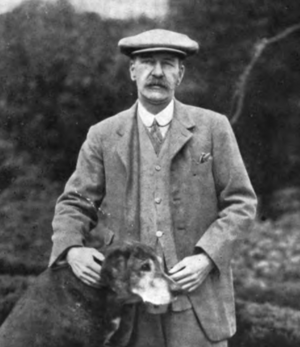Sir Alfred Rawlinson, 3rd Baronet facts for kids
Quick facts for kids
Sir Alfred Rawlinson, Bt
|
|
|---|---|

Alfred Rawlinson with dog George in 1924.
|
|
| Born | 17 January 1867 |
| Died | 1 June 1934 (aged 67) |
| Service/ |
British army, Royal Naval Reserve |
| Rank | Colonel |
| Unit | 17th Lancers, Royal Naval Air Service, Armoured Car Section, Royal Garrison Artillery, Intelligence Corps |
| Battles/wars | First World War, Battle of Aubers Ridge, German strategic bombing, Mesopotamian campaign (1918), Turkish War of Independence |
| Awards | Companion of the Order of St Michael and St George, Commander of the Most Excellent Order of the British Empire, Distinguished Service Order |
| Medal record | ||
|---|---|---|
| Men's polo | ||
| Representing a |
||
| Olympic Games | ||
| Gold | 1900 Paris | Team competition |
Sir Alfred "Toby" Rawlinson (born January 17, 1867 – died June 1, 1934) was an amazing English person who did many things! He was a soldier, a spy, a great sportsman, and even one of the first people to drive cars and fly planes. He was known as "Toby" to his family and friends.
Contents
Early Life
Alfred Rawlinson was born in London on January 17, 1867. His father, Sir Henry Creswicke Rawlinson, was a Major-General (a high-ranking army officer) and an expert on ancient Persia. Alfred's older brother, Henry Rawlinson, also became a famous general. He helped plan important battles that ended World War I.
Alfred went to a famous school called Eton College. After that, he went to the Royal Military College, Sandhurst, which is where people train to become army officers. He then joined the 17th Lancers, a cavalry unit.
A Talented Sportsman
Alfred Rawlinson was incredibly good at sports. He was a top-level polo player, which is a game played on horseback.
Polo Champion
He won many polo tournaments, including big ones in India and England. In 1900, he even won a Olympic gold medal in polo at the 1900 Summer Olympics in Paris! He stopped playing polo in 1911.
Racing Cars and Flying Planes
Alfred was also very interested in new technologies like cars and planes. He became a motor racing driver and even raced in the Isle of Man TT race in 1908.
He learned to fly planes in France, mostly teaching himself! He was one of the first people in the United Kingdom to get an official pilot's license in 1910. He was considered a natural pilot, even if he was a bit daring.
Serving in World War I
When World War I started in August 1914, Alfred was 47 years old. This was too old to be called up for the army. But he really wanted to help!
Driver and Inventor
He offered his own sports car and his driving skills to the British Army. He became a driver for important officers, carrying messages and supplies. His car even had a machine gun added to it!
Later, he helped the army get special mortars (a type of weapon) from the French army. These weapons were old, but they were very useful. They became known as "Toby mortars" after him! He was injured in battle in May 1915 and had to return to England to recover.
Protecting London from the Sky
While recovering, Alfred joined the Royal Naval Volunteer Reserve. He was asked to help protect London from German air attacks, especially from huge airships called Zeppelins.
He quickly found a special anti-aircraft gun in France and brought it back to London. This gun became the main weapon for a new mobile anti-aircraft unit he commanded. They could move their guns quickly to different spots around London to shoot down enemy airships. Alfred worked hard to improve how these guns were used. He even helped develop ways to find aircraft hidden in clouds using sound!
A Spy and Diplomat
In 1918, Alfred joined the Intelligence Corps, which is like a spy agency. He was sent on important missions to places like the Caucasus and Turkey.
One of his jobs was to make sure Turkey was following the rules of the armistice (a ceasefire) at the end of World War I. During one mission, he and his team were held prisoner by the Turkish authorities. It was a tricky situation, especially because his older brother was a very high-ranking general! Eventually, Alfred was released in an exchange of prisoners.
He wrote a book called Adventures in the Near East (1923), which described what it was like in those areas after the war.
Family Life
Alfred Rawlinson married Margarette Kennard in 1890. They had four children: twins Alfred Frederick and Honour Louisa, Irene Margarette, and another daughter named Mary who sadly died very young. Honour also passed away at age 12. Margarette died in 1907.
In 1913, Alfred married his second wife, Jean Isabella Griffin Aitkin. They later divorced.
When Alfred's older brother died in 1925, Alfred became the 3rd Baronet. This meant he inherited a special title, "Sir Alfred Rawlinson, 3rd Baronet."
Alfred Rawlinson died suddenly on June 1, 1934, at his home in London. He lived a very full and exciting life!

